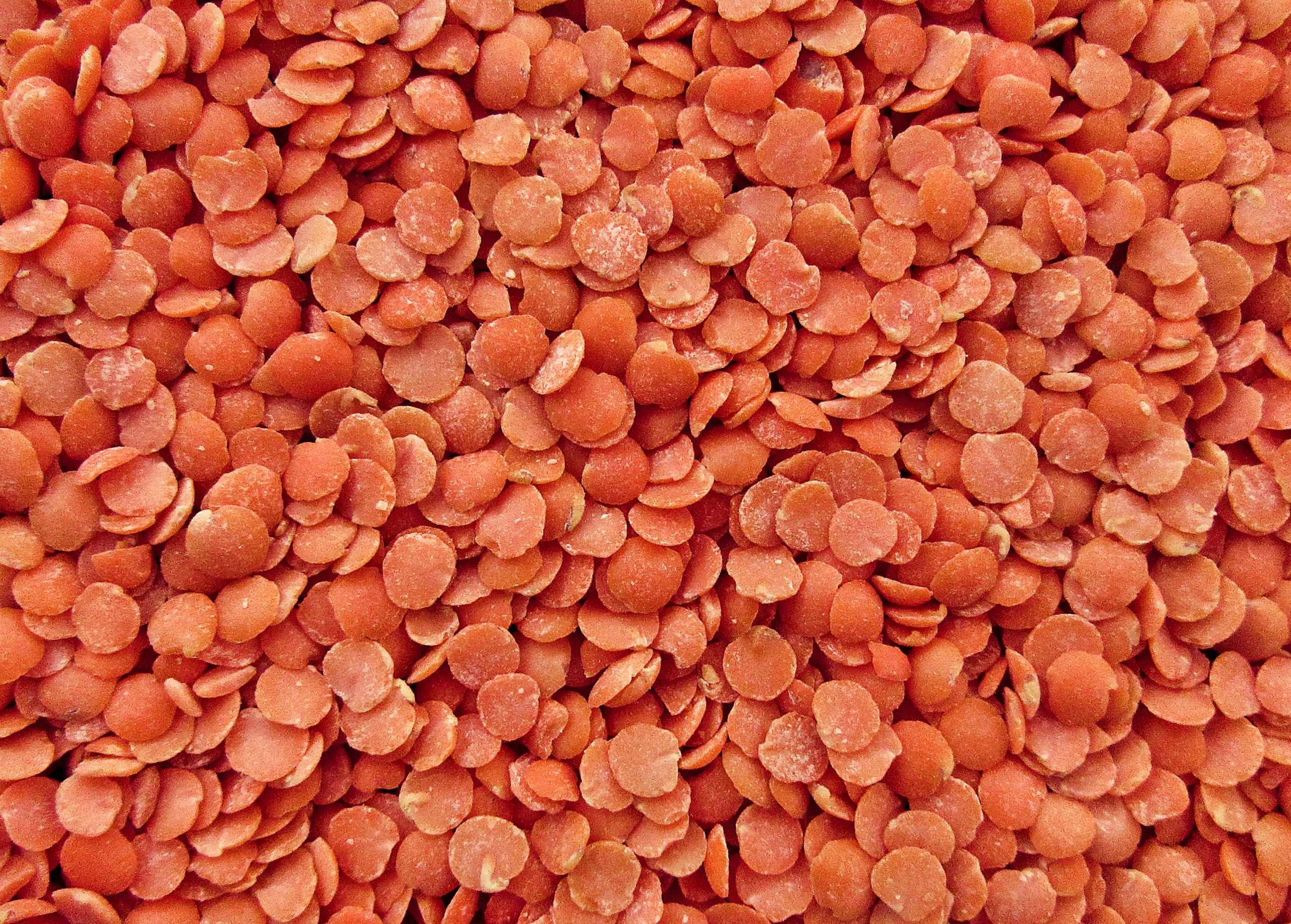Hello friends! My name is Rita Shushy Setrakian, and I have been working alongside Kate for past few weeks. I’m a dietetic intern at Teachers College, Columbia University, where I also earned my Master’s of Science degree in nutrition education. I love to experiment in the kitchen and share my creations with others!
Today, I am providing a post all about lentils! 
Personally, I love lentils because they’re easy to use, versatile and a great source of protein and fiber. Since many of Kate’s followers are interested in the low FODMAP diet, I wanted to share how lentils can fit in your nutrition repertoire – and in the low FODMAP diet overall.
When on a low FODMAP diet, the oligosaccharides present in legumes can be a potential GI symptom trigger. However, food processing can impact the oligosaccharide content in a food. When lentils soak and/or cook in water, this can lower the oligosaccharide content. The water soluble fibers, the oligosaccharides (FODMAPs) leach into the water, which you drain off prior to consumption.
Similarly, canned lentils undergo a comparable process, making them even lower in FODMAPs and convenient.
Why are canned lentils lower than simply cooking lentils?
It appears that the longer the lentils sit in the water, more FODMAPs escape into the water. Using canned lentils can save you some time in meal prep too.
When shopping for canned lentils, look for brands that do not contain other added FODMAPs ingredients such as garlic and onion.
Goya and WestBrae Natural are brands I prefer when buying plain, canned lentils. WestBrae Natural also has different types and provides a product that is much lower in sodium – great for heart health!
These brands below do not contain added onion or garlic.
Several types of lentils exist, including brown, puy, green, yellow, red and beluga. Monash University, the pioneers in FODMAP research and FODMAP food evaluation, have analyzed brown, green, red and Le Puy lentils for FODMAP content so we encourage these varieties to be used during the elimination phase of the diet.
While each lentil type is also unique in its phytochemical and antioxidant make-up, much of the nutrient content is the same.
For this recipe, I used Delallo Lentils!
The appropriate FODMAP portion size is ½ cup of canned lentils (or ¼ cup freshly boiled), and each Delallo can contains 3 servings.
Here are the nutrition facts for Delallo lentils per 1/2 cup serving!
Calories: 160 kcal
Carbohydrates: 33 g
Protein: 6 g
Fat: 0.5 g
Fiber: 6 g
Lentils are particularly high in protein, fiber, folate, iron, zinc and magnesium! Let’s talk a bit about these important nutritions.
Lentils contain 6 grams of protein in a 1/2 cup canned portion.
For those following a vegan or vegetarian diet, lentils make a great protein option. For those of us who do consume meat, they’re still a tasty, fiber rich, protein rich and nutrient dense ingredient!
Fiber is key for digestive health. One serving of Delallo canned lentils provides 6 grams of fiber; that’s about 25% of your daily requirement!
Lentils provide a great source of folate, a water-soluble B vitamin. While folate is crucial for all (it helps the body make healthy new cells), it is particularly important for women of reproductive age. Adequate folate intake can prevent birth defects of the baby’s brain, making it an important nutrient for those planning to conceive and during pregnancy.
Lentils provide a nice dose of plant-based iron too.
There are two types of iron – heme and non-heme – with heme iron being found in meat, poultry and fish, and non-heme iron being found in plant foods (whole grains, legumes, nuts, seeds and leafy greens). Non-heme iron is less readily absorbed in the gut, but pairing it with foods high in Vitamin C has been shown to increase absorption.
In my lentil recipe, we’ll be using lemon juice, tomato paste and kale as sources of Vitamin C, but some other foods high in Vitamin C include: bell peppers, strawberries, oranges and broccoli.
Lentils contain a good amount of zinc.
Zinc levels have been shown to be low in some GI conditions, such as chronic diarrhea, inflammatory bowel disease and celiac disease. Boost your zinc intake with lentils, or other zinc rich foods such as oyster, pork, or pumpkin seeds. For more information on zinc click here!
Lentils contain magnesium too!
Did you know that most of us don’t get enough magnesium?
Magnesium is an important mineral that helps regulate blood pressure and blood glucose, among a plethora of other crucial bodily functions. Lentils are a good source of magnesium. Pumpkin seeds, almonds, spinach, peanuts and avocados are some other food sources of magnesium.
Now that we know lentils can fit into the low FODMAP diet, let’s get to the fun part – cooking!
Lentils can be cooked in advance and kept in the fridge to be reused throughout the week, or you can opt to buy some of the canned varieties when on a low FODMAP diet. Whether you decide to sprinkle some over your salad or stir some into your soup, you’ll be adding a nutrient-dense ingredient to any dish.
Here’s a nutrient-packed lentil soup recipe, perfect for a chilly day! Check out these nourishing ingredients:
Disclaimer: This recipe contains FODY foods vegetable soup base; Kate works with FODY foods as an advisor.
Ingredients
- 2 tablespoons olive oil
- 3 large carrots, chopped
- 1 medium celery stalk, chopped
- 1 large potato (white), peeled and chopped into bite size pieces
- 4 teaspoons Fody Foods vegetable soup base dissolved in 4 cups of boiled water (or 4 cups of Low FODMAP vegetable broth)
- 3 cups canned lentils, rinsed and drained (about 2, 14 ounce cans, you may have a little lentils leftover, this can vary depending on the product you use.)
- 1, 14 ounce can diced tomatoes, not drained
- 3 cups kale, stemmed and chopped
- 1 tablespoon tomato paste
- ¼ teaspoon coriander
- ½ teaspoon cumin
- ½ teaspoon cayenne
- 1 teaspoon oregano
- Salt and pepper to taste
- 2 teaspoons lemon juice
- 1/2 cup parsley, washed and chopped, for garnish
Instructions
- In a large stockpot, add olive oil.
- Over medium-high heat, sauté carrots, celery and potato in olive oil for about 10-12 minutes or until soft.
- Add soup broth and cook for 5 minutes.
- Then, lower heat to medium, and continue to cook the vegetables for 15 minutes.
- Next, add the lentils, diced tomatoes, kale, tomato paste, coriander, cumin, cayenne, oregano, salt and pepper, to taste.
- Let soup simmer on medium-low heat for about 12 minutes, then stir in the lemon juice.
- Garnish with parsley and serve!
References for this post:
https://www.monashfodmap.com/blog/cooking-legumes/
https://www.cdc.gov/ncbddd/folicacid/about.html
https://www.ncbi.nlm.nih.gov/pmc/articles/PMC3967179/
https://www.hsph.harvard.edu/nutritionsource/iron/
https://pubmed.ncbi.nlm.nih.gov/6940487/
https://www.ncbi.nlm.nih.gov/pmc/articles/PMC4231515/
https://www.ncbi.nlm.nih.gov/pmc/articles/PMC5177471/
https://www.ncbi.nlm.nih.gov/pmc/articles/PMC1419071/pdf/gut00438-0045.pdf
https://ods.od.nih.gov/factsheets/Magnesium-HealthProfessional/



Albertina
Some people have suggested me low fodmap diet and I am looking for some recipes. This recipe looks great and it has lots of ingredients that are good for health. I will try this recipe today. Thanks for sharing the recipe!
katescarlata
Enjoy it, Albertina!
Carol Benjamin
This was a great article and recipe. Thank you for posting.
katescarlata
thanks Carol!
AnnMarie
I cannot find canned lentils in any store near me! But I love lentil soup, so I may have to order them online
Can I substitute spinach for kale? I’ve never had it (!) and I don’t want to ruin my soup… I can hardly wait to try this! Thanks.
katescarlata
Hi AnnMarie–yes you can definitely use spinach instead of kale. Enjoy!
Dr. Lucette Beall
This looks fabulous!! Quick question. I know you add the lemon juice just before serving because it can turn bitter if cooked in the soup. I am single and cook soups all the time and then portion them out (so 6 servings here) to have as meals throughout the week. Will the lemon juice negatively impact the taste when re-heating the soup? Thank you so much for your time and your delicious recipes!!
katescarlata
Great question–I can’t tell you for sure as I haven’t frozen this soup–but I think it should taste fine.
Lucette Beall
Thank you so much for your reply. I hope you had a wonderful Thanksgiving!!
katescarlata
You too, Lucette!